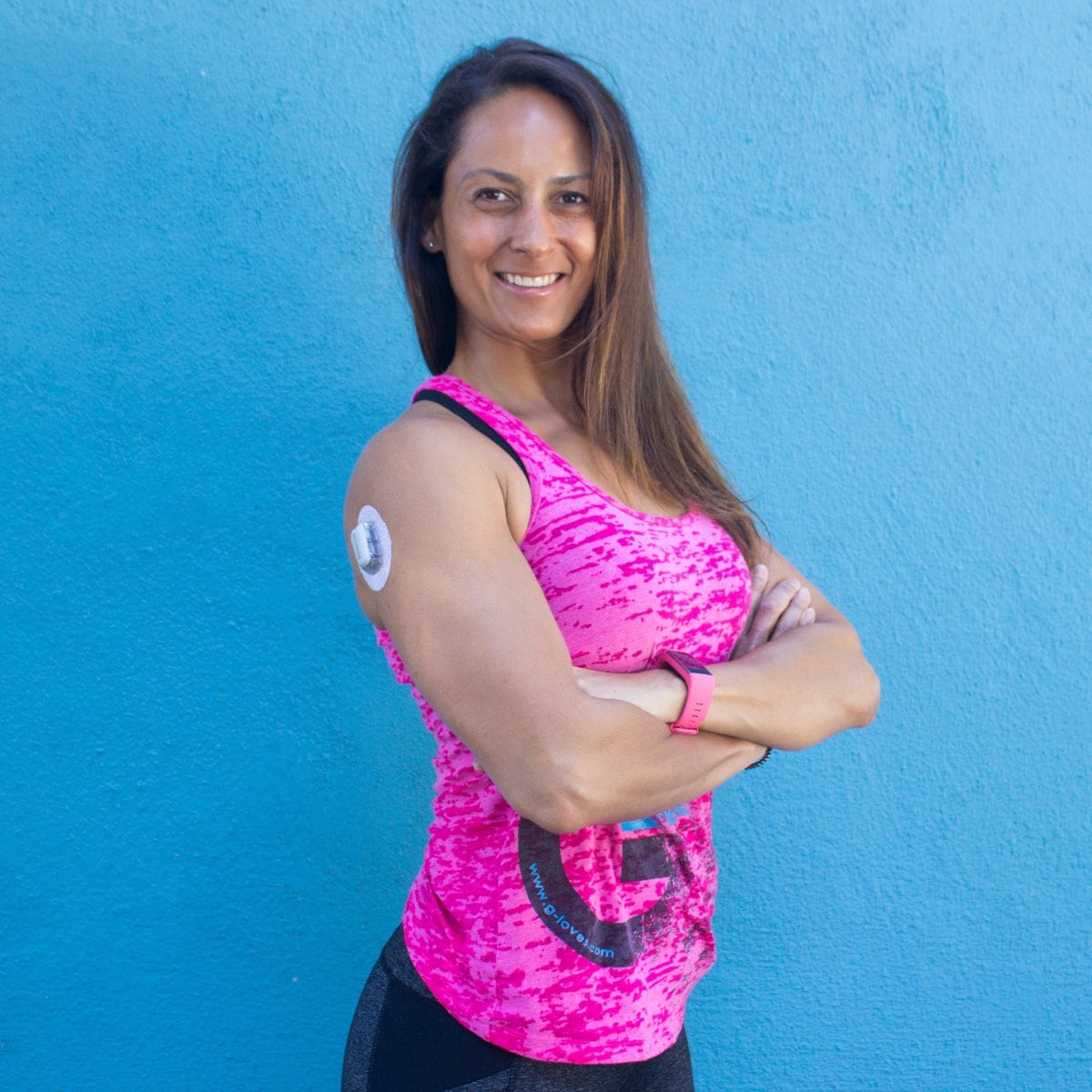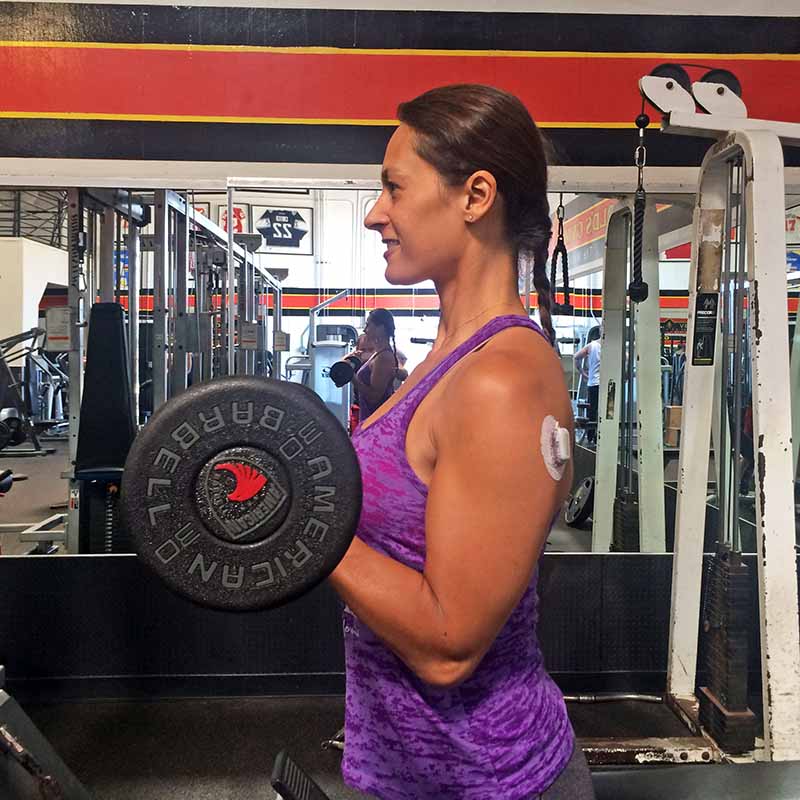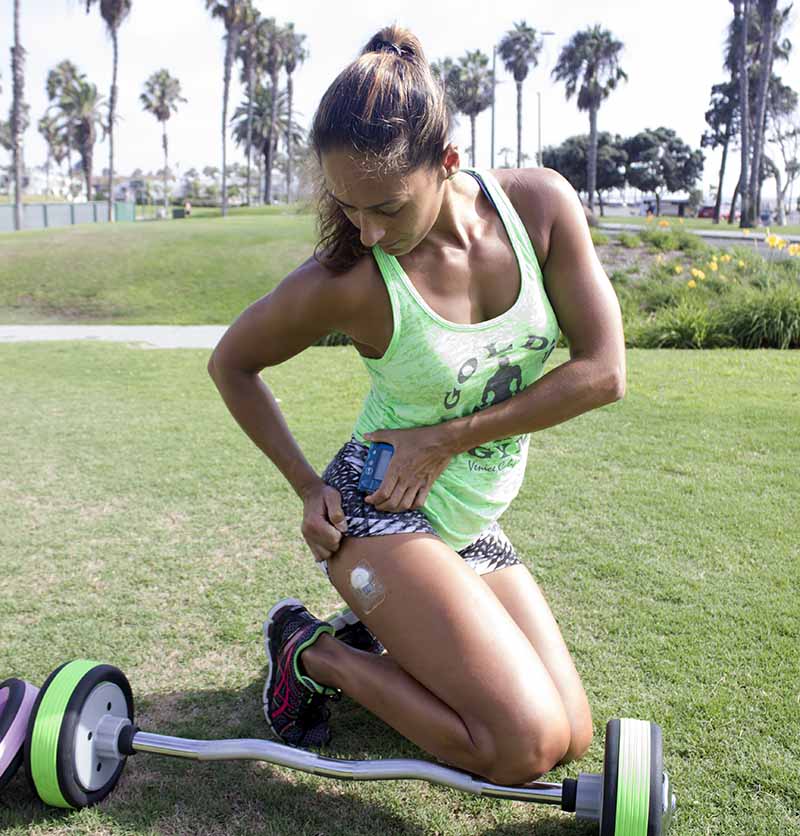You’ve probably seen me wearing a small device on my upper arm in a lot of the pictures on this website. That’s my continuous glucose monitor (CGM), a tool that’s instrumental in my daily diabetes management.
It’s a brilliant piece of equipment, and I absolutely love it (most of the time).

Key facts
- CGMs provide real-time and historical glucose data, improving awareness of how foods and activities affect glucose levels.
- These devices can help reduce episodes of hypoglycemia, improve A1c levels, and increase confidence and security in diabetes management.
- CGM use significantly reduces the need for traditional finger-stick monitoring, providing greater freedom in daily activities. This can provide peace of mind during exercise and other activities.
- Issues with CGM sensors can sometimes lead to inaccurate readings, potentially affecting diabetes management decisions, and the sensors can occasionally cause inconvenience or discomfort. Additionally, overreliance on the device can reduce personal judgment.
- Despite the potential drawbacks, CGMs are highly recommended for people with diabetes who take insulin, as they offer valuable insights into glucose trends and overall diabetes management.
- Which CGM system to use depends on a variety of factors, including compatibility with insulin pumps, smartphone integration and data accessibility, and lifestyle needs.
What is CGM?
A CGM device makes it possible for me to see my glucose readings in (almost) real-time and to track historical glucose data.
Most CGMs include three main components:
- A small sensor that is inserted just under the skin (where it reads glucose levels in interstitial fluid, or the fluid between body cells)
- An attached transmitter (this is the part you see on my arm), sends the readings to a receiving device
- A receiver or smartphone that displays the readings and glucose trend data
There are currently several CGM systems available for personal use in the United States:
- Abbott FreeStyle Libre 2
- Abbott FreeStyle Libre 3
- Ascensia Diabetes Care Eversense E3 (a fully implantable option)
- Dexcom G6
- Dexcom G7
- Medtronic Guardian Connect
My experience with CGM
I got my first Medtronic CGM in December 2012 and wore it every day for 18 months before taking a break. I then ordered my first Dexcom system in August 2016, and that has been my go-to since.
There are pros and cons to all CGM systems. Since I’ve only worn Medtronic and Dexcom devices to date, I’ll give you my opinions based on those so you can decide if a CGM might help you manage your diabetes better.
The advantages of CGM
Data
If you do finger-stick blood sugar checks and know your body well, you probably think you have a pretty good idea of what your sugars are up to between measurements. Chances are good, though, that you may be wrong.
I got a big surprise when I started seeing how much my blood sugar actually varied throughout the day, not to mention during the night when I usually don’t check.
CGM is a vital tool for providing this type of ongoing information over a 24-hour period that can show trends and patterns, as opposed to the snapshots at certain times during the day that are provided by traditional monitoring.
All of a sudden, I could see how certain foods and activities affected my glucose levels over the next several hours. That information is golden!
Plus, being able to spot low sugars before they hit (thanks to the alerts I set for when my sugar levels start dropping or get to a certain point) has really cut down on how often I have low blood sugar episodes.
It also means I’m consuming fewer glucose tablets and less juice to deal with said lows because I’m catching them earlier when less intervention is required to get my blood sugar back to the target range.
Management
So, what should we do with all this new information? In my case, it has not only helped me limit episodes of hypoglycemia (low blood sugar), but I have also managed to reduce my A1c level (a measure of glucose control over the previous 2 to 3 months) to around 6.0 percent.
My blood sugar has always been pretty well-regulated but has never been this stable before.
What’s more, some current CGM devices can integrate with an insulin pump, allowing you to monitor both glucose and insulin levels at the same time.
And certain devices combine CGM and insulin pump technology with an algorithm that automatically adjusts insulin dosing to help glucose stay within target range (the optimal level as determined by a person’s healthcare provider), in an innovation known as hybrid-closed loop (HCL) technology.
Current HCL devices on the market include:
- Medtronic MiniMed 770G
- Medtronic MiniMed 780G
- t:slim X2 Insulin Pump with Control-IQ Technology + Dexcom G6/G7
- Insulet Omnipod 5
Of course, just slapping on a CGM won’t manage your diabetes. However, careful interpretation and use of the data can help immensely.
For instance, I’ve learned that if I sleep any later than 8 a.m. before taking my morning insulin, I’ll be battling high morning blood sugar levels until at least noon.
I’ve also learned what kind of activities will make my sugars drop fast (in my case, that would be walking), my true levels of insulin sensitivity throughout the day, and that I always need a minimum of a half unit of active insulin on board (IOB) before a workout.
Gaining this knowledge took time and did include a few missteps, but that’s life, and that’s learning. The information has made it possible for me to optimize my training and has made it easier for me to stay in my desired range of 90 to 144 mg/dL (5.0 to 8.0 mmol/L) when exercising.
Confidence and security
My CGM has enabled me to understand my diabetes better. It has given me more confidence in the way I manage my condition and has helped me achieve tangible results.
It’s also comforting to know how my sugar levels are trending. I will even venture out sometimes without bringing all my diabetes gear. I also stopped monitoring 10 to 12 times a day because I no longer need to — the information is always right there on the screen in front of me.
Using this device has enabled me to go for a walk or a hardcore gym session without fearing lows and to reach both my fitness and diabetes health goals more efficiently.

The disadvantages of CGM
Accuracy
Anybody who has ever worn a CGM knows the frustration of doing a traditional finger-stick check and seeing that the sensor reading is off.
The reason behind this is that the technology isn’t perfect yet (although it is constantly improving), and the sensor measures your glucose levels in the interstitial fluid and not the blood. (There is generally a lag of a few minutes between your interstitial glucose levels and blood glucose levels)
Aside from the obvious issues, it can also be outright dangerous if you rely solely on the sensor readings and completely ignore what your body is telling you. For example, if the CGM alarms are going off telling you that you are at 250 mg/dL (13.9 mmol/L), it can be hard not to react immediately.
I have also had to stop workouts because the sensor incorrectly told me that my blood glucose was low or about to get low — always an annoying scenario when you’re in the midst of a good gym session.
Although some CGM devices are now highly accurate and approved by the U.S. Food and Drug Administration (FDA) for making treatment decisions, it is always wise to confirm any unexpected readings or readings that don’t match what your body is feeling with a traditional finger-stick before taking action.
(And several of the devices on the market, including the Medtronic Guardian and the Ascensia Eversense E3, require roughly two finger-stick checks a day for calibration.)
That said, it’s worth noting that the technology has improved tremendously over the years. According to a 2023 study, CGMs were shown to be 96.5 percent accurate in a real-world hospital setting.
Overreliance
This is actually the main reason why I originally stopped wearing my CGM and why I still take breaks on occasion.
This may not apply to everyone, but I have a tendency to rely on the readings and recommendations a bit too heavily. For example, if the reading said that my glucose was dropping quickly, I would trust it fully over how I actually feel. I think that’s a big no-no when it comes to diabetes management. In this scenario, it would be prudent to confirm the CGM information with a finger-stick check.
I have gotten a lot better at using the CGM as a data point and not necessarily as the complete truth, which has made it a far better partner in management.
Inconvenience
Having the CGM sensor attached to my body all the time can be extremely annoying. It’s not very big, and people don’t really notice it, but it can leave somewhat unattractive suntan marks. I also tend to scar easily.
If I wear it on my stomach, it tends to get in the way when working out, so I usually wear it on my upper arm. I find that I get pretty good readings with that placement. (One issue, though, is that it can be a little hard to get a sweaty sports bra off without ripping at the sensor.)
Wearing it on my upper arm has led to some pretty cool interactions and conversations with curious people. I don’t mind — I see it as an opportunity to educate and advocate.
But if it bothers you, there are plenty of other areas to place the sensor where it’s not visible. Typical manufacturers’ recommendations for sensor placement include the upper arm, stomach, lower back, thigh, and buttocks, depending on the specific device you’re using.
There are adhesives that can help strengthen the CGM’s adherence to your body. Refer to the instructions that come with your CGM and speak with your diabetes care provider about approaches that can work for you.
On a related topic, many people wonder if CGMs hurt. In my experience, there is only a slight pinching sensation upon inserting the sensor, and this momentary discomfort is well worth the data the device provides.
Plus, for the devices currently on the market, the sensors only need to be changed every 7 to 15 days (with the exception of the implantable Eversense E3, which typically needs to be changed by a healthcare provider every 90 to 180 days).
Related: Here is a post outlining my best CGM tips in which I talk more about how to put on the sensor (with a video) and how to make it stay on.
Price
Depending on your health insurance coverage, CGM devices and their associated supplies can be expensive. Check with your insurance provider to determine what costs are associated with CGM for you.

Final thoughts
Would I recommend a CGM to anyone with diabetes using insulin? The answer is a resounding yes, at least until you understand your body and your diabetes better.
The CGM will give you knowledge about your diabetes that you have never had before, and if, after a while, you feel like you no longer need it, speak with your diabetes care provider about other options.
The key for me when using my CGM is to get better at listening to both the CGM and my body. It’s a fantastic device, but it’s not a substitute for my own thinking and experience.
It’s a great tool to have in my diabetes toolbox, but it can’t stand alone.





NeilTaylor
A great piece of information thank you 👍🏼
Doreen
Just last Friday received my Libra 3 Freestyle CGM. I just did a finger stick test on my One Touch Verio Reflect and it says 85 while the CGM is telling me 124. The Libra 3 was set up and put on at the Dr office. Why are the readings so far off?
Christel Oerum, MS
There can be different reasons why finger sticks and your CGM reading aren’t the same.
It’s considered accurate +/- 20 mg/dl or percentage (yours is further off than that). You can expect more inaccurate numbers during the first 24 hours as the sensor adjusts to your body.
If it continues to be very inaccurate you might have a bad sensor. However, if your blood sugars are changing rapidly the readings won’t be the same. A CGM measures your blood sugar in the fluid under your skin and that is about 10 min behind your blood. So to summarize, you can only expect the readings to be within +/- 20 after the first 24 hours and when blood sugars are steady.
M Parker
Thanks for this great article. I have been a T1D since 1989 and started using a CGM 3 years ago. I was originally hesitant, but have grown to love this piece of technology! I agreed with your comments in general and as you suggested, it’s important for individuals to realize they should trust their body over the CGM reading. I’ve had instances where the CGM says my sugars are 80, but I get up to get something and immediately the number is much less than that, or vice versa. When in doubt, get the glucometer out!
avni
Thanks for sharing such valuable information. Your perspective is refreshing and has given me a lot to think about.
Lucinda
Just a hint with the Dexcom sensors: My experience is that for the first 24 hours the Dexcom sensors are just not accurate….this has also been stated by the Dexcom agents that I have spoken to. They tell me not to calibrate for the first 24 hours as it takes that long for the sensor/filament to get used to the body. It was just so frustrating to have to do finger sticks for the first day! So I started putting on a new sensor 24 hours before the existing sensor expired. Of course it cannot be paired to the pump yet but it is giving the new sensor/filament time to get used to my body. When the old sensor expires I pair the new one and within 5 seconds I have accurate readings. No waiting for the 2 hours with the G6 or 30 minutes with the G7 to warm up.
Mark Jackson
The Dexcom G6 changed my life. I am physically very active and encounter low blood sugar levels. The warning in the DexcomG6 was superb. Unfortunately I became allergic to the chemicals in the adhesive substance used to attach the Dexcom to my skin. I developed painful blood blisters which forced me to give up the Dexcom and revert to finger testing. It was like returning to the dark ages! I contacted Dexcom but made no progress.
Your article is excellent.
Anne Margolis
This is a very balanced article that I wish I’d had access to before I began using a CGM. Unlike ads and other sources, this article admits that users must still rely on blood testing at times; that not all CGM readings are accurate; and that there is always a time gap between blood test readings and CGM readings. The only point that I might differ about is the amount of time that can elapse between the blood test results being mirrored by or coming close to the CGM results. In my experience, that gap can be as long as 30+ minutes, though it can also be about 20 minutes. And, just as the author of this article states, it can be very difficult to prevent yourself from reacting as soon as you get a warning from your CGM, instead of checking first by a blood test or by how your body actually feels. Overall, though, an excellent article.